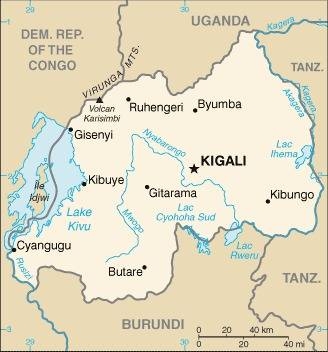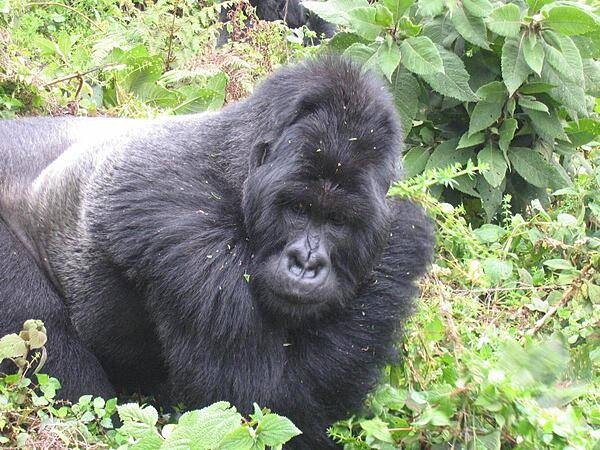216 Rwanda

Three horizontal bands of sky blue (top, double width), yellow, and green, with a golden sun with 24 rays near the fly end of the blue band. Blue represents happiness and peace, yellow economic development and mineral wealth, green hope of prosperity and natural resources. The sun symbolizes unity, as well as enlightenment and transparency from ignorance.
Flag courtesy of the CIA World Factbook

Map courtesy of the CIA World Factbook

Silverback Mountain Gorilla, Volcanoes National Park.
Photo courtesy of the CIA World Factbook
Government
According to Britannica, the constitution promulgated in 1978 established a presidential form of government. The president at the time, Juvénal Habyarimana, combined the roles of head of state and head of government with that of president of what was then the single ruling party, the National Revolutionary Movement for Development. A revised constitution was enacted in 1991 that allowed for multiparty participation in government. In 1994, however, after Habyarimana’s death, the country slipped into chaos before elections could be held. The legislative body under the 1978 constitution, the unicameral National Development Council, was replaced by the Transitional National Assembly in 1994, which enacted another constitution in 1995. A new constitution promulgated in 2003 employed strong language decrying the ethnic strife of the past, listing the resolutions to “fight against the ideology of genocide and all its manifestations” and “the eradication of ethnic, regional and other divisions and the promotion of national unity” among its fundamental principles.
Rwanda is a multiparty republic. Under the 2003 constitution, the president, who serves as head of state, was directly elected to a seven-year term, renewable once. In 2015 the constitution was amended to allow the president at the time, Paul Kagame, to run for a third consecutive seven-year term in 2017 and, after that, for presidents to serve a five-year term renewable once. The president selects a prime minister, who serves as the head of government.
Legislative power is exercised by a bicameral parliament, which consists of the Chamber of Deputies and the Senate. Deputies serve five-year terms. About two-thirds are directly elected. The rest of the deputies are indirectly elected: two are elected by the National Youth Council; one is elected by the Federation of the Association of the Disabled; and the remaining seats are allocated to female representatives elected by local government bodies. Senators serve nonrenewable eight-year terms; under the 2015 amended constitution, that will change to a five-year term, renewable once, beginning after 2019. Twelve are elected by local government bodies; two are elected from among lecturers and researchers of universities and institutions of higher education, one from public universities and one from private universities; eight are selected by the president; and four are selected by the Forum of Political Organizations (a regulatory body).
For administrative purposes, the country is divided into four provinces (North, East, South, and West) and one city (Kigali), each headed by a governor. The country had previously been divided in 10-12 prefectures since independence, but the administrative structure was reorganized in 2006 in an effort to decentralize power and create multiethnic areas.
Rwanda’s constitution provides for an independent judiciary, which is based on German and Belgian civil law systems and customary law. The Supreme Court is the highest court; other courts include the High Court of the Republic, provincial courts, district courts, and municipal and town courts.
Rwanda also uses the traditional gacaca legal system. In precolonial days gacaca courts were traditionally used to resolve conflict between families. The courts were held outside, and the heads of households served as judges. In the 21st century, this system was adapted to judge those accused of committing genocide in 1994. This was done because the tremendous number of people to be tried in connection with the genocide resulted in a massive backlog of cases and an inability to proceed in a timely manner. To alleviate the problem, the government in 2001 proposed trying the majority of cases, consisting of lesser crimes, in gacaca courts; the courts were inaugurated in 2002 and began operating in phases over the next several years. Those accused of the more serious crimes of planning, instigating, and leading the genocide were to be tried through Rwanda’s court system, while the top officials involved were to be tried by the United Nations International Criminal Tribunal for Rwanda, held in Arusha, Tanz.
Rwanda Civil Aviation Authority (RCAA)
Rwanda Civil Aviation Authority (RCAA) is mandated to regulate and ensure oversight of Aviation Safety, Security, Economic regulation of Air Services and development of Civil Aviation as guided by the provisions of the Convention on International Civil Aviation Organization’s Standards and Recommended Practices (SARPs). In replacement of the Rwanda Airport Authority established in 1986, Civil Aviation Authority (CAA) was created by law No. 21/2004 of 10/08/2004 to take on the management, operation and maintenance of airport infrastructure. The law was later revised in 2006 by law no 44/2006 of 05/10/2006 forming Rwanda Civil Aviation Authority (RCAA), mandated to assume both regulatory functions and the operation of airports and the provision of Air Navigation Service (ANS). To implement the Government policy of separating operational from regulatory functions, the law No 03/2017 of 21/02/2017 was issued; then the law No. 007/2019 of 13/04/2019 was promulgated mandating the RCAA to perform regulatory functions.
Airspace
SkyVector – Google Maps – ADS-B Exchange
ICAO countries publish an Aeronautical Information Publication (AIP). This document is divided into three parts: General (GEN), En Route (ENR) and Aerodromes (AD). ENR 1.4 details the types of airspace classes they chose to adopt from classes A through G.
Drone Regulations
RCAA-AC-UAS-21-001 – Unmanned Aircraft System (UAS) advisory circular.
RCAA UAS Applicant form
RCAA-Form-CONOPS-UAS001: – Concept of Operations to apply for UAS Operation
RCAR Part 27: Rwanda UAS Regulation
Advanced Air Mobility (AAM) Regulations & Policies
None found by the author.
However, should you, the reader, happen to stumble across something to the contrary, please email the author at FISHE5CA@erau.edu and you may be mentioned in the ACKNOWLEDGEMENTS section of this book by way of thanks for contributing to this free eBook!
Advanced Air Mobility (AAM) News
2025 – Rwanda Launches Africa’s First Drone-Based Air Taxi Service
2025 – Rwanda conducts autonomous air taxi demo
2025
Video courtesy of Advanced Air Mobility Institute from the January 2025 Global AAM Forum. Complete session for Day 1 of this Forum is available on the Advanced Air Mobility Institute YouTube Channel
Short Essay Questions
Scenario-Based Question
You have been hired by a Drone Startup Company. Your boss has immediately assigned this job to you.
They need you to prepare a one-page memo detailing the legalities of using a drone to film the wildlife in Volcanoes National Park.
They need you to mention any national laws and local ordinances.
They specifically want to know what airspace (insert pictures) you will be operating in and whether or not you need an airspace authorization.
Does it matter whether or not you are a citizen of the country?
Lastly, there is a bonus for you if, as you scroll through this chapter, you find any typos or broken links!
Short Essay Questions
- What are the drone categories?
- How is registration addressed?
- How is remote ID addressed?
- What are the model aircraft rules?
- What are the commercial drone rules?
- Are there waivers or exemptions to the rules? If so, for what?
- Would you share a link to an interactive airspace map?
- How is BVLOS addressed?
- How can you fly drones at night?
- How can you fly drones over people?
- Where do you find drone NOTAMs?
- What are the rules for drone maintenance?
- What are the rules for an SMS program?
- What are some unique rules not mentioned above?
- What are the C-UAS rules?
- What are the AAM rules?

